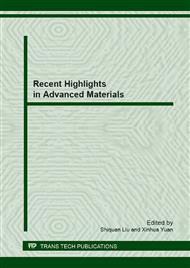[1]
Leng JS, Lan X, Liu YJ, Du SY, Shape-memory polymers and their composites: Stimulus Methods and applications, Prog Mater Sci. 56(2011)1077-135.
DOI: 10.1016/j.pmatsci.2011.03.001
Google Scholar
[2]
Behl M, Lendlein A, Shape memory polymers, Mater Today. 10(2007)20-8.
Google Scholar
[3]
Wagermaier W, Kratz K, Heuchel M, Lendlein A, Characterization methods for shape-memory polymers, Adv Polym Sci. 226(2010) 97-145.
DOI: 10.1007/12_2009_25
Google Scholar
[4]
Xie T, Recent advances in polymer shape memory, Polymer. 52(2011) 4985-5000.
DOI: 10.1016/j.polymer.2011.08.003
Google Scholar
[5]
Xie T, Tunable polymer multi-shape memory effect, Nature. 464(2010) 267-70.
Google Scholar
[6]
Meng QH, Hu JL, A review of shape memory polymer composites and blends, Compos Part A-Appl S. 40(2009) 1661-72.
Google Scholar
[7]
Tobushi H, Okumura K, Hayashi S, Ito N, Thermomechanical constitutive model of shape memory polymer, Mech Mater. 33(2001) 545-54.
DOI: 10.1016/s0167-6636(01)00075-8
Google Scholar
[8]
Liu YP, Gall K, Dunn ML, Greenbery AR, Diani J, Thermomechanics of shape memory polymers: Uniaxial experiments and constitutive modeling, Int J Plasticity. 22(2006) 279-313.
DOI: 10.1016/j.ijplas.2005.03.004
Google Scholar
[9]
Heuchel M, Cui J, Kratz K, Kosmella H, Lendlein A, Relaxation based modeling of tunable shape recovery kinetics observed under isothermal conditions for amorphous shape-memory polymers, Polymer. 51(2010)6212-18.
DOI: 10.1016/j.polymer.2010.10.051
Google Scholar
[10]
Diani J, Gilormini P, Frédy C, Rousseau I, Predicting thermal shape memory of crosslinked polymer networks from linear viscoelasticity, Int J Solids Struct. 49(2012)793-9.
DOI: 10.1016/j.ijsolstr.2011.11.019
Google Scholar
[11]
Ward IM, Sweeney J, An Introduction to the Mechanical Properties of Solid Polymers, England (2004).
Google Scholar
[12]
Qi HJ, Boyce MC, Stress–strain behavior of thermoplastic polyurethanes, Mech Mater. 37(2005)817-39.
Google Scholar
[13]
L. Luo, X.X. Wang, Y.X. Jia, Z.J. Wang, Recovery performance and characteristics in shape memory effects of aliphatic polyether urethane, accepted by Polymers for Advanced Technologies (2013).
DOI: 10.1002/pat.3133
Google Scholar
[14]
Ge Q, Luo XF, Rodriguez ED, Zhang X, Mather PT, Dunn ML, Qi HJ, Thermomechanical behavior of shape memory elastomeric composites, J Mech Phys Solids. 60(2012)67-83.
DOI: 10.1016/j.jmps.2011.09.011
Google Scholar


